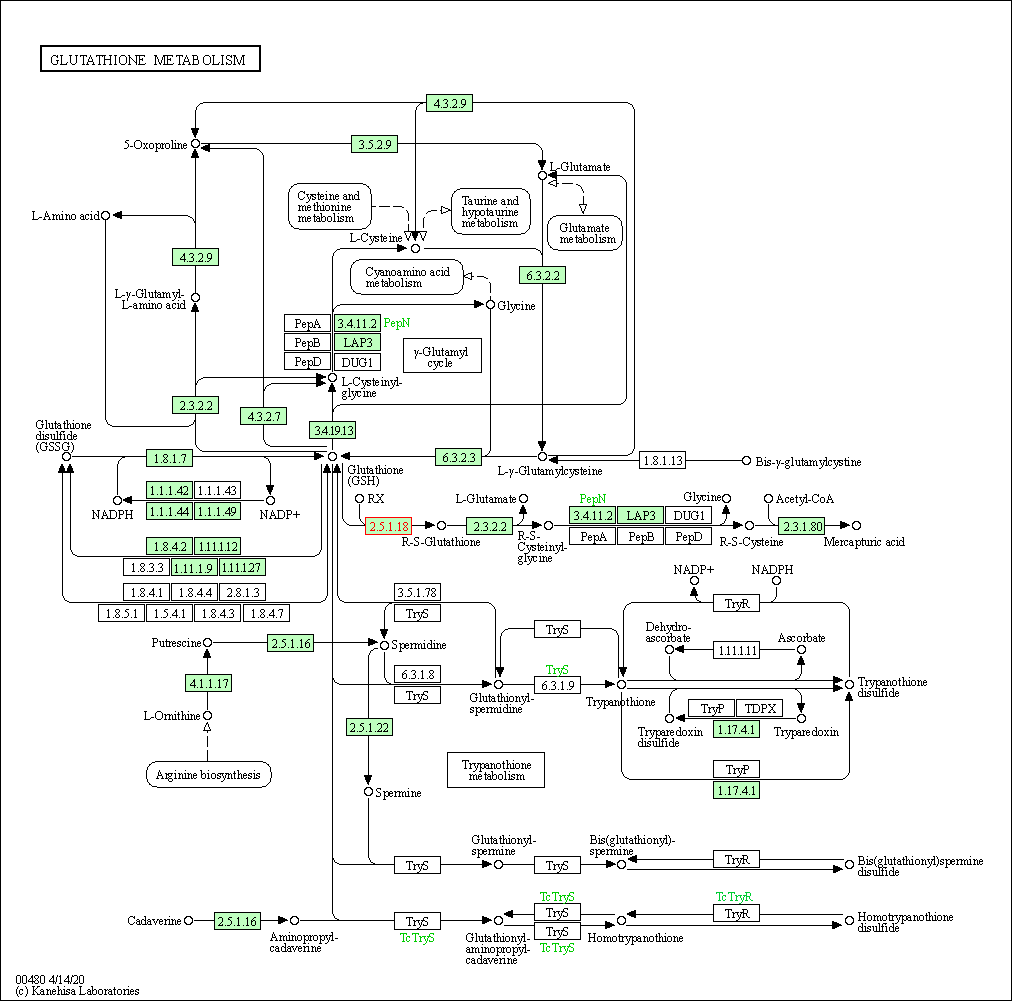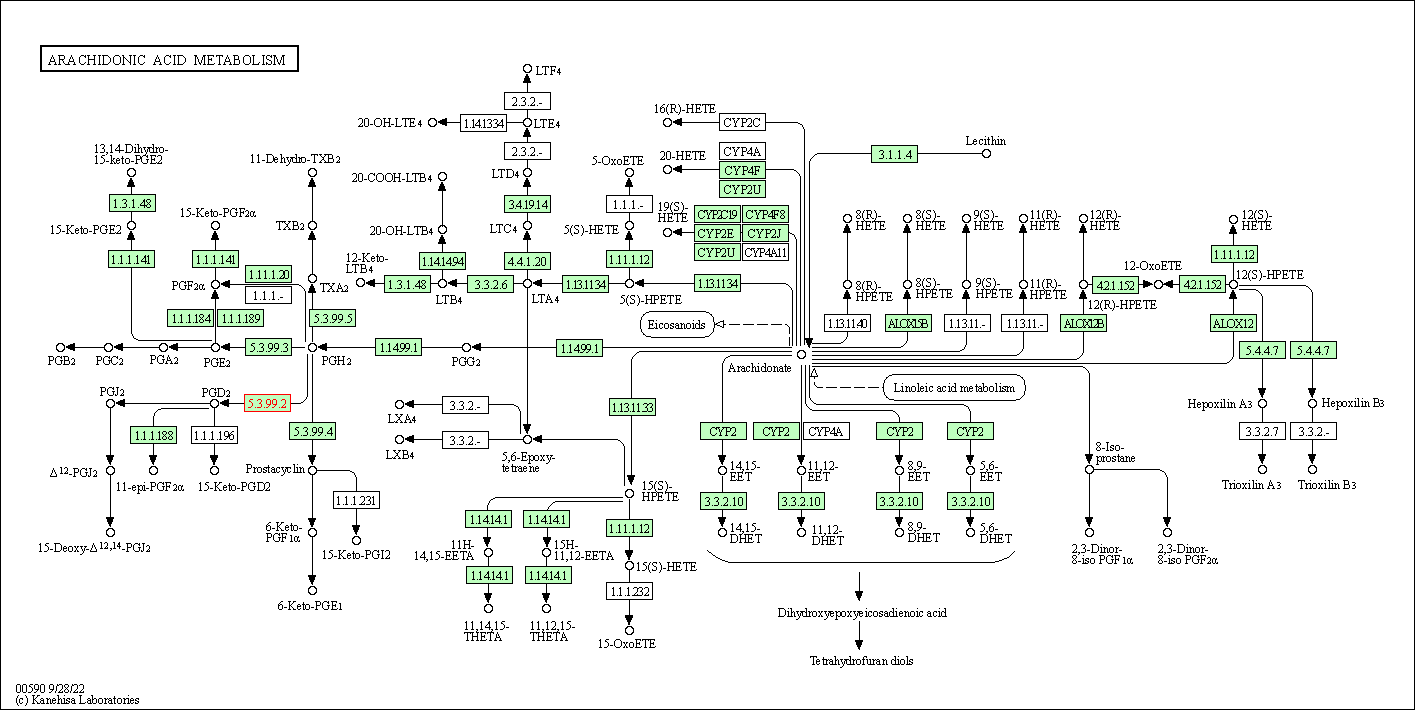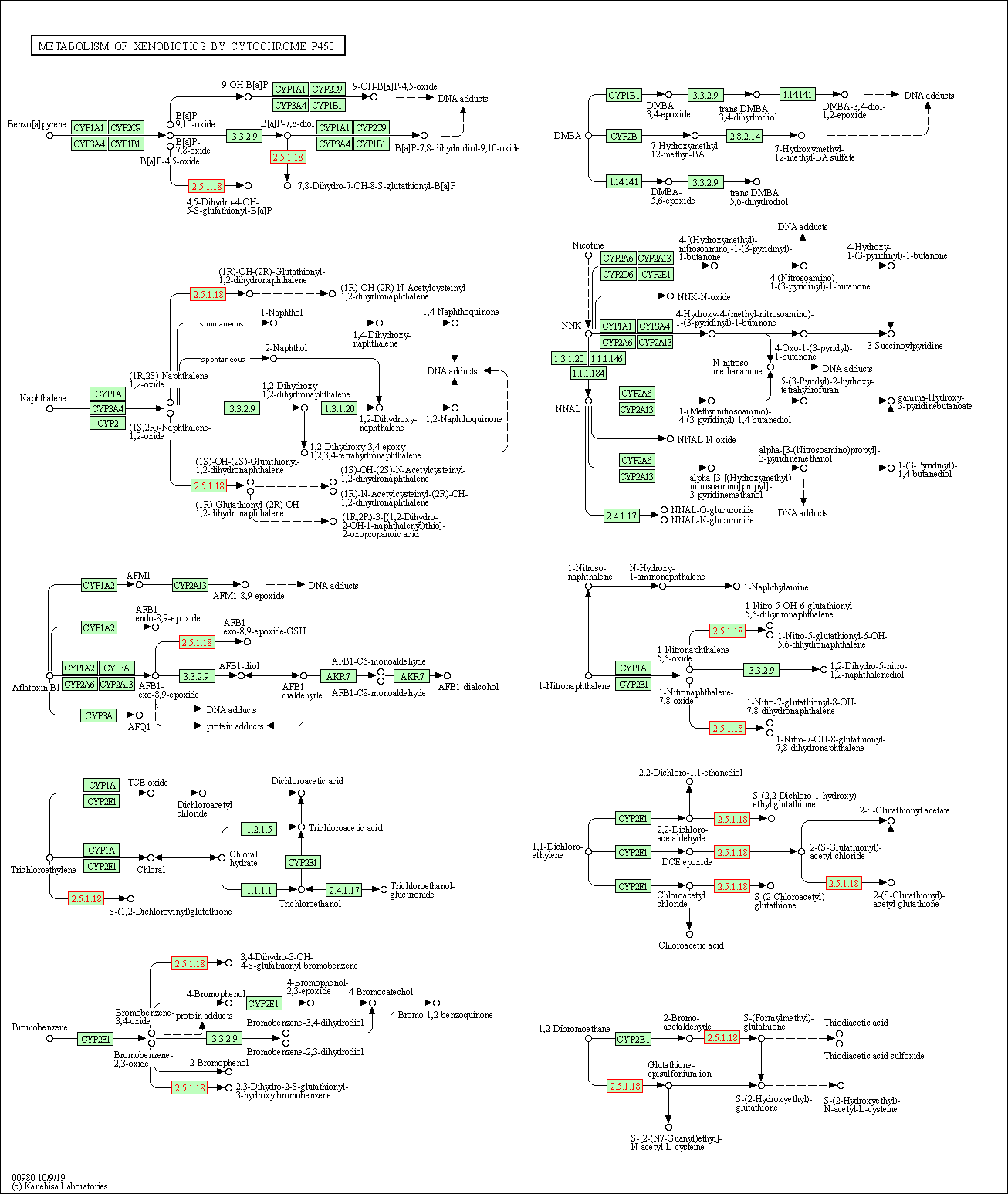Target Information
| Target General Information | Top | |||||
|---|---|---|---|---|---|---|
| Target ID |
T19433
(Former ID: TTDS00192)
|
|||||
| Target Name |
Glutathione-dependent PGD synthase (HPGDS)
|
|||||
| Synonyms |
HPGDS; Glutathione-S-transferase; GST class-alpha
Click to Show/Hide
|
|||||
| Gene Name |
HPGDS
|
|||||
| Target Type |
Successful target
|
[1] | ||||
| Disease | [+] 1 Target-related Diseases | + | ||||
| 1 | Flatworm infection [ICD-11: 1F70-1F86] | |||||
| Function |
Bifunctional enzyme which catalyzes both the conversion of PGH2 to PGD2, a prostaglandin involved in smooth muscle contraction/relaxation and a potent inhibitor of platelet aggregation, and the conjugation of glutathione with a widerange of aryl halides and organic isothiocyanates. Also exhibits low glutathione-peroxidase activity towards cumene hydroperoxide.
Click to Show/Hide
|
|||||
| BioChemical Class |
Intramolecular oxidoreductases
|
|||||
| UniProt ID | ||||||
| EC Number |
EC 5.3.99.2
|
|||||
| Sequence |
MPNYKLTYFNMRGRAEIIRYIFAYLDIQYEDHRIEQADWPEIKSTLPFGKIPILEVDGLT
LHQSLAIARYLTKNTDLAGNTEMEQCHVDAIVDTLDDFMSCFPWAEKKQDVKEQMFNELL TYNAPHLMQDLDTYLGGREWLIGNSVTWADFYWEICSTTLLVFKPDLLDNHPRLVTLRKK VQAIPAVANWIKRRPQTKL Click to Show/Hide
|
|||||
| 3D Structure | Click to Show 3D Structure of This Target | PDB | ||||
| HIT2.0 ID | T78T4E | |||||
| Drugs and Modes of Action | Top | |||||
|---|---|---|---|---|---|---|
| Approved Drug(s) | [+] 1 Approved Drugs | + | ||||
| 1 | Praziquantel | Drug Info | Approved | Flatworm infection | [2] | |
| Clinical Trial Drug(s) | [+] 1 Clinical Trial Drugs | + | ||||
| 1 | HF-0220 | Drug Info | Phase 2 | Alzheimer disease | [3] | |
| Mode of Action | [+] 2 Modes of Action | + | ||||
| Inhibitor | [+] 6 Inhibitor drugs | + | ||||
| 1 | Praziquantel | Drug Info | [1] | |||
| 2 | Cibacron blue | Drug Info | [5] | |||
| 3 | Formic Acid | Drug Info | [6] | |||
| 4 | HQL-79 | Drug Info | [7] | |||
| 5 | Protoporphyrin IX | Drug Info | [8] | |||
| 6 | S-hexylglutathione | Drug Info | [9] | |||
| Stimulator | [+] 1 Stimulator drugs | + | ||||
| 1 | HF-0220 | Drug Info | [4] | |||
| Cell-based Target Expression Variations | Top | |||||
|---|---|---|---|---|---|---|
| Cell-based Target Expression Variations | ||||||
| Drug Binding Sites of Target | Top | |||||
|---|---|---|---|---|---|---|
| Ligand Name: Glutathione | Ligand Info | |||||
| Structure Description | H-PDGS complexed with a 2-phenylimidazo[1,2-a]pyridine-6-carboxamide inhibitors | PDB:7JR8 | ||||
| Method | X-ray diffraction | Resolution | 1.13 Å | Mutation | No | [10] |
| PDB Sequence |
GMPNYKLTYF
9 NMRGRAEIIR19 YIFAYLDIQY29 EDHRIEQADW39 PEIKSTLPFG49 KIPILEVDGL 59 TLHQSLAIAR69 YLTKNTDLAG79 NTEMEQCHVD89 AIVDTLDDFM99 SCFPWAEKKQ 109 DVKEQMFNEL119 LTYNAPHLMQ129 DLDTYLGGRE139 WLIGNSVTWA149 DFYWEICSTT 159 LLVFKPDLLD169 NHPRLVTLRK179 KVQAIPAVAN189 WIKRRPQTKL199 |
|||||
|
|
||||||
| Click to View More Binding Site Information of This Target and Ligand Pair | ||||||
| Ligand Name: HQL-79 | Ligand Info | |||||
| Structure Description | Crystal structure analysis of human hematopoietic prostaglandin D synthase complexed with HQL-79 | PDB:2CVD | ||||
| Method | X-ray diffraction | Resolution | 1.45 Å | Mutation | No | [7] |
| PDB Sequence |
PNYKLTYFNM
11 RGRAEIIRYI21 FAYLDIQYED31 HRIEQADWPE41 IKSTLPFGKI51 PILEVDGLTL 61 HQSLAIARYL71 TKNTDLAGNT81 EMEQCHVDAI91 VDTLDDFMSC101 FPWAEKKQDV 111 KEQMFNELLT121 YNAPHLMQDL131 DTYLGGREWL141 IGMSVTWADF151 YWEICSTTLL 161 VFKPDLLDNH171 PRLVTLRKKV181 QAIPAVANWI191 KRRPQTKL
|
|||||
|
|
||||||
| Click to View More Binding Site Information of This Target with Different Ligands | ||||||
| Different Human System Profiles of Target | Top |
|---|---|
|
Human Similarity Proteins
of target is determined by comparing the sequence similarity of all human proteins with the target based on BLAST. The similarity proteins for a target are defined as the proteins with E-value < 0.005 and outside the protein families of the target.
A target that has fewer human similarity proteins outside its family is commonly regarded to possess a greater capacity to avoid undesired interactions and thus increase the possibility of finding successful drugs
(Brief Bioinform, 21: 649-662, 2020).
Human Tissue Distribution
of target is determined from a proteomics study that quantified more than 12,000 genes across 32 normal human tissues. Tissue Specificity (TS) score was used to define the enrichment of target across tissues.
The distribution of targets among different tissues or organs need to be taken into consideration when assessing the target druggability, as it is generally accepted that the wider the target distribution, the greater the concern over potential adverse effects
(Nat Rev Drug Discov, 20: 64-81, 2021).
Human Pathway Affiliation
of target is determined by the life-essential pathways provided on KEGG database. The target-affiliated pathways were defined based on the following two criteria (a) the pathways of the studied target should be life-essential for both healthy individuals and patients, and (b) the studied target should occupy an upstream position in the pathways and therefore had the ability to regulate biological function.
Targets involved in a fewer pathways have greater likelihood to be successfully developed, while those associated with more human pathways increase the chance of undesirable interferences with other human processes
(Pharmacol Rev, 58: 259-279, 2006).
Biological Network Descriptors
of target is determined based on a human protein-protein interactions (PPI) network consisting of 9,309 proteins and 52,713 PPIs, which were with a high confidence score of ≥ 0.95 collected from STRING database.
The network properties of targets based on protein-protein interactions (PPIs) have been widely adopted for the assessment of target’s druggability. Proteins with high node degree tend to have a high impact on network function through multiple interactions, while proteins with high betweenness centrality are regarded to be central for communication in interaction networks and regulate the flow of signaling information
(Front Pharmacol, 9, 1245, 2018;
Curr Opin Struct Biol. 44:134-142, 2017).
Human Similarity Proteins
Human Tissue Distribution
Human Pathway Affiliation
Biological Network Descriptors
|
|
|
There is no similarity protein (E value < 0.005) for this target
|
|
Note:
If a protein has TS (tissue specficity) scores at least in one tissue >= 2.5, this protein is called tissue-enriched (including tissue-enriched-but-not-specific and tissue-specific). In the plots, the vertical lines are at thresholds 2.5 and 4.
|




| KEGG Pathway | Pathway ID | Affiliated Target | Pathway Map |
|---|---|---|---|
| Glutathione metabolism | hsa00480 | Affiliated Target |

|
| Class: Metabolism => Metabolism of other amino acids | Pathway Hierarchy | ||
| Arachidonic acid metabolism | hsa00590 | Affiliated Target |

|
| Class: Metabolism => Lipid metabolism | Pathway Hierarchy | ||
| Metabolism of xenobiotics by cytochrome P450 | hsa00980 | Affiliated Target |

|
| Class: Metabolism => Xenobiotics biodegradation and metabolism | Pathway Hierarchy | ||
| Drug metabolism - cytochrome P450 | hsa00982 | Affiliated Target |

|
| Class: Metabolism => Xenobiotics biodegradation and metabolism | Pathway Hierarchy | ||
| Degree | 3 | Degree centrality | 3.22E-04 | Betweenness centrality | 5.38E-05 |
|---|---|---|---|---|---|
| Closeness centrality | 2.31E-01 | Radiality | 1.41E+01 | Clustering coefficient | 0.00E+00 |
| Neighborhood connectivity | 8.37E+01 | Topological coefficient | 3.40E-01 | Eccentricity | 11 |
| Download | Click to Download the Full PPI Network of This Target | ||||
| Chemical Structure based Activity Landscape of Target | Top |
|---|---|
| Drug Property Profile of Target | Top | |
|---|---|---|
| (1) Molecular Weight (mw) based Drug Clustering | (2) Octanol/Water Partition Coefficient (xlogp) based Drug Clustering | |
|
|
||
| (3) Hydrogen Bond Donor Count (hbonddonor) based Drug Clustering | (4) Hydrogen Bond Acceptor Count (hbondacc) based Drug Clustering | |
|
|
||
| (5) Rotatable Bond Count (rotbonds) based Drug Clustering | (6) Topological Polar Surface Area (polararea) based Drug Clustering | |
|
|
||
| "RO5" indicates the cutoff set by lipinski's rule of five; "D123AB" colored in GREEN denotes the no violation of any cutoff in lipinski's rule of five; "D123AB" colored in PURPLE refers to the violation of only one cutoff in lipinski's rule of five; "D123AB" colored in BLACK represents the violation of more than one cutoffs in lipinski's rule of five | ||
| Target Poor or Non Binders | Top | |||||
|---|---|---|---|---|---|---|
| Target Poor or Non Binders | ||||||
| Target Profiles in Patients | Top | |||||
|---|---|---|---|---|---|---|
| Target Expression Profile (TEP) |
||||||
| Target Affiliated Biological Pathways | Top | |||||
|---|---|---|---|---|---|---|
| BioCyc | [+] 1 BioCyc Pathways | + | ||||
| 1 | C20 prostanoid biosynthesis | |||||
| KEGG Pathway | [+] 2 KEGG Pathways | + | ||||
| 1 | Arachidonic acid metabolism | |||||
| 2 | Metabolic pathways | |||||
| WikiPathways | [+] 3 WikiPathways | + | ||||
| 1 | Arachidonic acid metabolism | |||||
| 2 | Aryl Hydrocarbon Receptor | |||||
| 3 | Integrated Pancreatic Cancer Pathway | |||||
| Target-Related Models and Studies | Top | |||||
|---|---|---|---|---|---|---|
| Target Validation | ||||||
| References | Top | |||||
|---|---|---|---|---|---|---|
| REF 1 | X-ray structure of glutathione S-transferase from Schistosoma japonicum in a new crystal form reveals flexibility of the substrate-binding site. Acta Crystallogr Sect F Struct Biol Cryst Commun. 2005 Mar 1;61(Pt 3):263-5. | |||||
| REF 2 | Opportunities and challenges in antiparasitic drug discovery. Nat Rev Drug Discov. 2005 Sep;4(9):727-40. | |||||
| REF 3 | ClinicalTrials.gov (NCT00357357) European Study of HF0220 in Mild to Moderate Alzheimer's Disease Patients. U.S. National Institutes of Health. | |||||
| REF 4 | US patent application no. 2009,0062,529, Multi-cyclic compounds. | |||||
| REF 5 | A novel method for screening the glutathione transferase inhibitors. BMC Biochem. 2009 Mar 16;10:6. | |||||
| REF 6 | How many drug targets are there Nat Rev Drug Discov. 2006 Dec;5(12):993-6. | |||||
| REF 7 | Structural and functional characterization of HQL-79, an orally selective inhibitor of human hematopoietic prostaglandin D synthase. J Biol Chem. 2006 Jun 2;281(22):15277-86. | |||||
| REF 8 | Inhibition of glutathione-S-transferase from Plasmodium yoelii by protoporphyrin IX, cibacron blue and menadione: implications and therapeutic bene... Parasitol Res. 2008 Mar;102(4):805-7. | |||||
| REF 9 | Purification and catalytic properties of glutathione transferase from the hepatopancreas of crayfish macrobrachium vollenhovenii (herklots). J Biochem Mol Toxicol. 2004;18(6):332-44. | |||||
| REF 10 | A knowledge-based, structural-aided discovery of a novel class of 2-phenylimidazo[1,2-a]pyridine-6-carboxamide H-PGDS inhibitors. Bioorg Med Chem Lett. 2021 Sep 1;47:128113. | |||||
If You Find Any Error in Data or Bug in Web Service, Please Kindly Report It to Dr. Zhou and Dr. Zhang.

